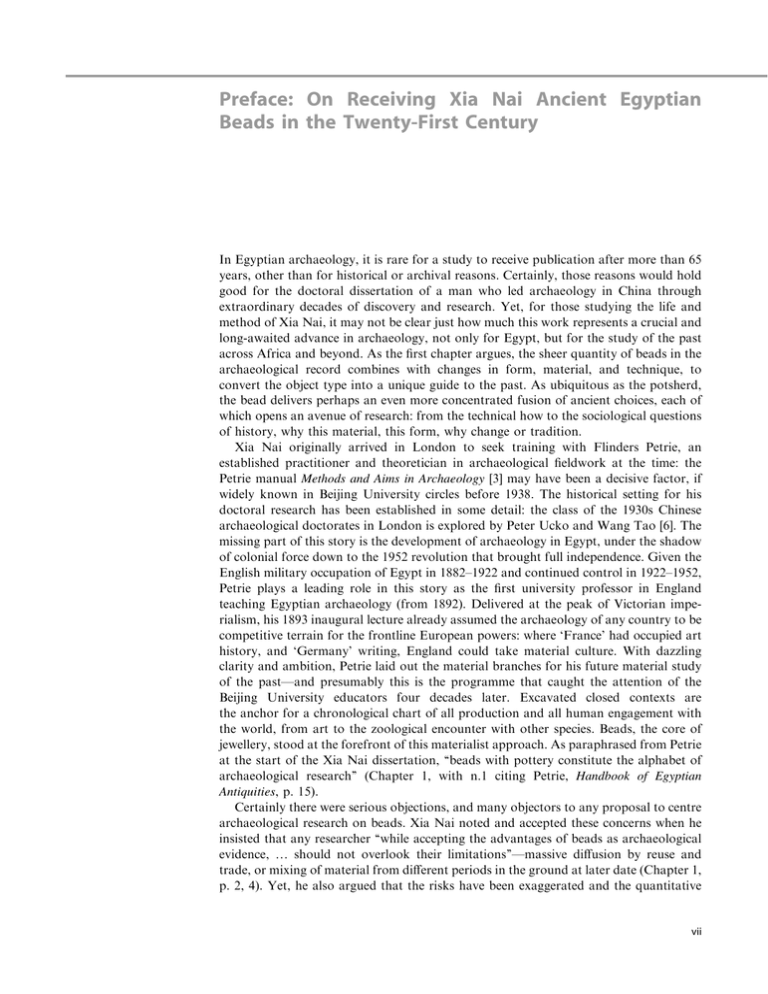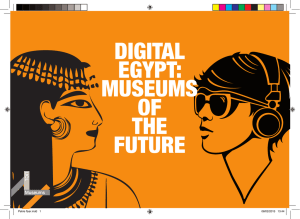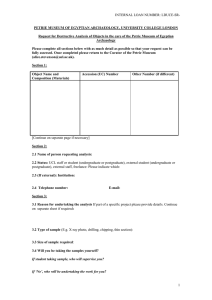Preface: On Receiving Xia Nai Ancient Egyptian
advertisement

Preface: On Receiving Xia Nai Ancient Egyptian Beads in the Twenty-First Century In Egyptian archaeology, it is rare for a study to receive publication after more than 65 years, other than for historical or archival reasons. Certainly, those reasons would hold good for the doctoral dissertation of a man who led archaeology in China through extraordinary decades of discovery and research. Yet, for those studying the life and method of Xia Nai, it may not be clear just how much this work represents a crucial and long-awaited advance in archaeology, not only for Egypt, but for the study of the past across Africa and beyond. As the first chapter argues, the sheer quantity of beads in the archaeological record combines with changes in form, material, and technique, to convert the object type into a unique guide to the past. As ubiquitous as the potsherd, the bead delivers perhaps an even more concentrated fusion of ancient choices, each of which opens an avenue of research: from the technical how to the sociological questions of history, why this material, this form, why change or tradition. Xia Nai originally arrived in London to seek training with Flinders Petrie, an established practitioner and theoretician in archaeological fieldwork at the time: the Petrie manual Methods and Aims in Archaeology [3] may have been a decisive factor, if widely known in Beijing University circles before 1938. The historical setting for his doctoral research has been established in some detail: the class of the 1930s Chinese archaeological doctorates in London is explored by Peter Ucko and Wang Tao [6]. The missing part of this story is the development of archaeology in Egypt, under the shadow of colonial force down to the 1952 revolution that brought full independence. Given the English military occupation of Egypt in 1882–1922 and continued control in 1922–1952, Petrie plays a leading role in this story as the first university professor in England teaching Egyptian archaeology (from 1892). Delivered at the peak of Victorian imperialism, his 1893 inaugural lecture already assumed the archaeology of any country to be competitive terrain for the frontline European powers: where ‘France’ had occupied art history, and ‘Germany’ writing, England could take material culture. With dazzling clarity and ambition, Petrie laid out the material branches for his future material study of the past—and presumably this is the programme that caught the attention of the Beijing University educators four decades later. Excavated closed contexts are the anchor for a chronological chart of all production and all human engagement with the world, from art to the zoological encounter with other species. Beads, the core of jewellery, stood at the forefront of this materialist approach. As paraphrased from Petrie at the start of the Xia Nai dissertation, ‘‘beads with pottery constitute the alphabet of archaeological research’’ (Chapter 1, with n.1 citing Petrie, Handbook of Egyptian Antiquities, p. 15). Certainly there were serious objections, and many objectors to any proposal to centre archaeological research on beads. Xia Nai noted and accepted these concerns when he insisted that any researcher ‘‘while accepting the advantages of beads as archaeological evidence, … should not overlook their limitations’’—massive diffusion by reuse and trade, or mixing of material from different periods in the ground at later date (Chapter 1, p. 2, 4). Yet, he also argued that the risks have been exaggerated and the quantitative vii viii Preface: On Receiving Xia Nai Ancient Egyptian Beads in the Twenty-First Century potential underestimated: while a researcher should avoid ‘‘drawing conclusions from isolated examples’’ (p. 5), careful attention to context does enable archaeologists to distinguish use and reuse, and assess the less frequent cases of reuse within each period. Analysis should include study of ‘‘signs of wear and tear’’ (p. 3), but above all should build on well-documented excavation, in Egyptian archaeology on the cemetery documentation methods established by Petrie and his foremost 1920–1930s follower Guy Brunton (p. 4). As the research must avoid misleading single items, and build on Petrie and Brunton, Xia Nai finds the most solid material base in the ‘‘Petrie Collection in University College, London’’ (pp. 5–6), supported by two other principal collections formed mainly from excavation, the Egyptian Museum, Cairo and the Ashmolean Museum, Oxford. His intimacy with the material grew from the intensive labour of registering ‘‘over a thousand strings’’ (p. 7). The resulting index of 1760 cards provides for each string eight items of information: ‘‘registration number, provenance, date, use, reference, remarks, drawing, and photograph number’’; and, more astonishingly, for each type of bead on the string, six further items observed: ‘‘form, perforation, colour, material, decoration, and number’’ (pp. 7–8). The recording took place just before the entire UCL Egyptian archaeology collection was packed up for safe storage during wartime, a massive operation calling on all hands, including Xia Nai as a graduate student of the college. As a result, the index preserves a considerable amount of information since lost, and on these terms alone will be of great value to any future researchers into any of the finds from the excavations. A single example may illustrate this extraordinary value of the Xia Nai corpus as primary documentation. The card for string 1593 records two green faience beads of type 311A4, PN8b, from ‘‘Kahun, Illahun (1889) XII’’, meaning the late Middle Kingdom town-site near al-Lahun, cleared for Petrie by a trained Fayoumi team in 1889, and named by Petrie ‘‘Kahun’’. The card adds that there was also a green glazed steatite cylinder ‘‘carved with three crocodiles’’, and that the material was from a ‘‘mummy on floor—E end Rank A’’. 1889 is early in the history of development of archaeological recording methods for settlement sites, and Petrie made himself sole recorder for the clearance of a town 250 by 280 metres. Consequently, the Petrie excavation reports give no stratigraphy, and very few find spots. However, in his first of two seasons of recording, Petrie did assign letters to the blocks of housing between streets, and published a plan that includes Rank A. In his publications on the site, and in his weekly ‘Journals’ to a small personal circle of readers in England, there is no mention of the cylinder, or of the presence of any burials in this row of buildings [2]. Instead, the available record for Rank A, apart from the card, gives the impression of ‘regular’ town houses. Now, Petrie did record finds in two Rank A houses (perhaps joined at some point), including arguably the most important single item from the Lahun excavations—the only ancient Egyptian mask surviving from a domestic context. The repairs on the mask indicate that this was used extensively; the lion-like face of the mask evoking the birth-protecting deity Aha (later called Bes), and the other finds in the houses (figurine of lion-face woman, musical clappers) suggest equipment for birthing rituals. However, the presence of a burial nearby reminds us how fragile the documentation for the site is, and how ‘‘we must be careful in drawing conclusions from isolated examples’’ (Xia Nai, p. 5). Suddenly we realise the limits to our knowledge even for such an exceptionally important archaeological landscape. The earlier interpretation of the unique mask may remain the most plausible, but we need the carefully documented contexts of more recent excavations, as at Elephantine [5] before we can impose our strict division between living and dead on the finds. This is just one instance where the Xia Nai records may extend and change the picture from early excavations on which much of our archaeology and history of Egypt have been constructed. Preface: On Receiving Xia Nai Ancient Egyptian Beads in the Twenty-First Century ix In order to provide full access to the research underpinning the dissertation, Petrie Museum Manager Tonya Nelson and Conservation Manager Susanna Pancaldo secured funding for the digitisation and online publication of the Xia Nai cards. Kristin A. Phelps provided the time and the paper conservation experience and training to undertake the digital photography of all index cards; guidance and facilities were generously provided by Stuart Laidlaw, lecturer in archaeological photography at the Institute of Archaeology. Thanks to their time and care, the cards were all digitised in 2011, and Sam Washington UCL Museums and Collections Information Officer has created webpages for access to these new digital resources on the Petrie Museum website in 2012. The cards allow a full appreciation of the great research operation as developed by Xia Nai; his characteristically meticulous attention to detail in recording is sustained across the entire chronological series that had accumulated at UCL from the work of Flinders Petrie and his contemporaries and immediate successors. Xia Nai took care to specify the parameters of the research and its corpus in space and time (p. 6): geographically, as Egypt (including imports from outside, as well as Sinai, but excluding Nubia, at the time not represented in the collection), and, chronologically, down to the first millennium BC (Petrie’s ‘‘Roman-Coptic,’’ more or less the first millennium AD, is strongly represented in the collection, but would have exceeded the constraints of a London Ph.D.). A greater problem lay in defining the formal material limits to the dissertation. Xia Nai notes how subjective it is to separate beads from amulets in archaeology: he cites the colonial classic study by Winifred Blackman, Fellahin of Upper Egypt [1], for the observation that ‘‘in modern Egypt, necklaces of ordinary blue beads are worn as charms against the evil eye’’ (p. 6). This observation could be greatly expanded with more extensive documentation from the great collection of materials worn for health, assembled by Dr. Tawfik Canaan in Palestine during the early twentieth century, under English occupation. Future research may reunite what anthropology and archaeology have divided between them. For the initial study of the beads, scientific analysis required a hypothetical, testable base, the fictive ‘objective’, and so the question was left suspended, bracketed for the future: the bead was accepted as the non-figurative form, leaving intact the category of Amulets as the part of the collection published by Petrie under that name two decades earlier (pp. 6–7). The summary offered to readers implies a whole future research programme: ‘‘throughout this essay, the term ‘beads’ is used in this qualified sense, that is, it includes ordinary beads and pendants, but excluding amulets’’ (p. 7). This future research never happened. Under the exceptional historical conditions of its completion, the research never received publication, either in England or in China: war and revolution carried both its author and his supervisor (Stephen Glanville) and examiners into other worlds of action. As a study of Egypt, perhaps it fell too far outside the priorities of national excavation and training. In London, the three men most able to appreciate its impact were his supervisor Steven Glanville, the successor to Petrie as UCL Professor and curator, and the archaeologists with greatest expertise in study of beads, Guy Brunton and Oliver Myers. All may have lost contact with the author, and were themselves soon lost to archaeology, as they found postwar employment elsewhere (Glanville) or not at all (Brunton and Myers). Still more extraordinarily, no one else in the archaeology of Egypt or of Africa took up the task of publishing a corpus or a corpus-based study of the beads of the region. The global encyclopedias have perhaps filled the gap sufficiently for fieldwork, or the older publications by fieldworkers such as Brunton have perhaps been enough for comparative study. Perhaps, even in London the successful dissertation of Xia Nai deterred anyone from simply repeating what for many others would amount to a lifetime of work. No one took up the task, leaving still a gaping hole at the centre of the practice and theory of archaeology in northeast Africa, a gap with direct impact on the study of its most closely related lands in west Asia and southeast Europe. Publication of the core work and its supporting corpus may, then, be x Preface: On Receiving Xia Nai Ancient Egyptian Beads in the Twenty-First Century the missing necessary condition for continuing this crucial area of study into a vital part of life. For the ‘ordinary bead’ offers us something universally precious: our most material and most intimate connection, between human as lived body and a tangible world of sensation. Prof. Stephen Quirke References 1. Blackman, W. (1927). Fellahin of upper Egypt. London. 2. Gallorini, C. (1998). A reconstruction of Petrie’s excavation at the Middle Kingdom settlement of Kahun. In S. Quirke (Ed.), Lahun studies (pp. 42–59). Reigate: SIA Publishing. 3. Petrie, W.M.F. (1904). Methods and aims in archaeology. London. 4. Petrie, W.M.F. (1915). Handbook of Egyptian antiquities, collected by Professor Flinders Petrie. University College London: London. 5. Pilgrim, C. von (1996). Elephantine XVIII. Die stadt des mittleren reiches und der zweiten zwischenzeit. Mainz: Philipp von Zabern. 6. Ucko, P., & Tao, W. (2007). Early archaeological fieldwork practice and syllabuses in China and England. In P. Ucko et al. (Eds.), From concepts of the past to practical strategies: the teaching of archaeological field techniques (pp. 35–56). London: Saffron Press. http://www.springer.com/978-3-642-54867-3


